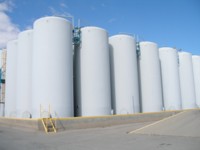
Above, commercial tanks store huge quantities of mash
Dave,
What’s your experience/opinion on not using a mash for a commercial hot sauce? Can it be practical?
Our most popular hot sauce is based on cayennes, and we’ve always used fresh peppers for the recipe. Now I’m looking to have this sauce professionally made and bottled, and I’m wondering about the cost of using fresh peppers–seems like everyone uses mash for the cost/convenience.
The only alternative is to modify the recipe to use cayenne mash with vinegar, which I’m finding is extremely hard to come by; in small quantities. (Obviously I cannot invest in a large batch up front if I’m not even sure it will work for my purposes)
Thanks for your time,
Jared
Hello Jared,
Since cayennes are a seasonal crop, I suggest that you find a gardener or farmer who can grow large amounts of cayenne pods. Remove the seeds and stems and follow the following recipe:
Frozen Chile Mash
Here is one of the best methods for processing and preserving large quantities of small chile pods quickly. The way is so basic that it is sometimes overlooked among preservation methods. You should have a powerful blender or food processor for this. To use, defrost the cubes and estimate 2 to 3 pods per cube. Use in recipes calling for minced or chopped small chiles.
Fresh chile pods, such as cayenne, red jalapeño, habanero, or rocoto, seeds and stems removed
Water as needed
Place the chile pods in a food processor or blender with a little water and process to a medium-thin puree. Take care not to breathe the fumes from the pureeing. Pour the puree into plastic ice cube trays and freeze solid. Pop the cubes out and double bag them in zip bags. Label and place back in the freezer.
Yield: Varies
Heat Scale: Hot to Extremely Hot
Dave




